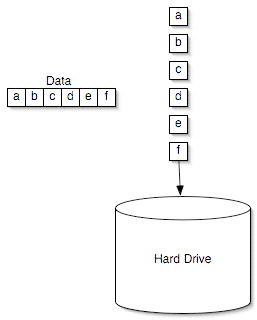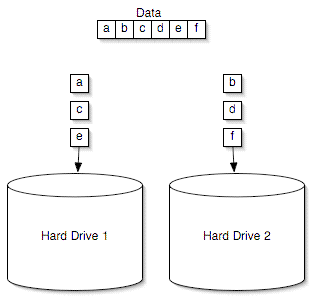Western Digital's Raptors in RAID-0: Are two drives better than one?
by Anand Lal Shimpi on July 1, 2004 12:00 PM EST- Posted in
- Storage
Doubling Theoretical Performance: RAID-0
For those of you who are already familiar with RAID and how it works, go ahead and skip to the benchmarks; these next two pages are designed to serve as brief introductions to the two most common forms of RAID on the desktop: RAID-0 and RAID-1.Otherwise known as striping, RAID-0 is the only performance-enhancing form of RAID that we'll be talking about in this article. The premise behind striping is simple. Data being written to a drive is split into "stripes", generally 16 - 256KB in size, with each stripe being written to a different drive in the array. For example, say we were dealing with a 2-drive RAID-0 array with a stripe size of 128KB and we wanted to write 256KB of data; drive 0 would get the first 128KB of data written to it, and drive 1 would get the remaining 128KB.

Writing to a single hard disk

Writing to a two-disk RAID-0 array
Here, you can see that the write performance of RAID-0 can be almost double that of a single drive, since twice as much data gets written at the same time. The higher write performance is obtained at the expense of some controller overhead, since the RAID controller has to handle splitting up data into stripes before sending it to the drives themselves - but with modern day microprocessors being as fast as they are, the overhead is usually thought of as negligible.
Reading works the exact same way, but in reverse. Say that we want to read that same 256KB of data back; we pull one stripe from drive 0 and the other stripe from drive 1. The read is now completed in half the time, theoretically doubling performance.
We are careful to use the word "theoretical" because the performance advantages of RAID-0 disappear quickly if we're not dealing in ideal situations like the ones we just described. If too large of a stripe size is used, then the performance advantages of RAID-0 can be lost, while too small of a stripe size could result in excess overhead, reducing the performance improvement of the striped array.
We have seen in the past that for most desktop applications, the largest stripe size that a desktop RAID controller will offer is usually the best choice for performance. With Intel's ICH5/6, that translates into a 128KB stripe size, which for our comparison is what we decided to go with. The other stripe size options didn't offer any better performance for our desktop test suite.
The main downside to RAID-0, other than cost, is reliability. The size of a RAID-0 array is the sum of all of its members; so, two 100GB drives in a RAID-0 array will give you one array with a 200GB total capacity. Unfortunately, if you lose any one of the drives in the array, all of your data is lost and isn't recoverable. Since two drives are working in tandem and are both necessary to hold your data, you effectively halve the mean time between failure by moving to a two-drive RAID-0 array.










127 Comments
View All Comments
bhvm - Tuesday, June 22, 2010 - link
t1n0m3n,Agreed cent percent.
Whereas our processors are zooming in Ghz and Rams in GBs... Our old humble HDDs are still around 60MB/.s
A properly setup RAID (with dedicated controller) will give close to 90% performance boost. I run Software RAID 0 on my laptop (its a monster laptop with 2 x 7200 RPM seagate momentus) for My database... Its just not about the Raw speed and numbers... the machine 'feels' damm so fast. Also, despite being software RAID, Single drive gives 45MB/s.... Whereas RAID 0 partition gives easily 85 MB/s/.
Long live the RAID!
Ambress - Wednesday, November 10, 2004 - link
While this article on RAID was quite informative, I would be very interested in seeing what the measured peformance differences are for an application such as Photoshop, where a secondary hard drive assigned as a scratch disk is recommened for optimum performance. Perhaps one problem here is finding some reliable Photoshop benchmarking tool, but surely one exists. Even without that, just performing a repeatable action that exercises a series of steps that are certain to force scratch disk usage could demonstrate what RAID 0 advantages exist, when used as the scratch disk. Such a test would likely require the manipulation also of a rather large image file...perhaps 100MB or more. I suspect other applications that work with large data files, such as video editing applications, would also benefit noticeably from a RAID 0 array. If this doesn't prove to be the case, then my plans for my next PC could be simplified and costs reduced. I've anticipated building a system with a RAID 0 system drive and a RAID 0 data drive, although I'm now thinking that RAID 0 for a system drive may be overkill.DatabaseMX - Tuesday, October 19, 2004 - link
At the beginning of the article:"Unfortunately, if you lose any one of the drives in the array, all of your data is lost and isn't recoverable."
If you lose your drive in a single drive system, all of your data is lost and isn't recoverable, thus, the above statement has no special meaning. However, in both cases, if you have backed up your drives, then you can recover. Also, I fail to see how two drives in a RAID 0 will halve the MTBF.
This review is hardly based on any scientific approach - one controller / motherboard combination and one brand of hard drive. Get real. And to not delve into WHY there was only minimal performance increase further dilutes the results of this review/test.
#64 pretty much spells it all out - nice job.
#87 (et.al) ... It doesn't matter if it doubles, triples or 1000 times it ... just like with ONE drive ... you are hosed if you don't have a full system backup! The primary concept of RAID 0 is to get more performance, not to worry about drive failure. If you are worried about drive failure, then use RAID 1 or some other RAID level which deals with redundancy.
Backup is the key here. And I can attest that Acronis True Image (www.acronis.com) is one brilliant piece of backup software. I have used it in multiple scenarios, including restoring an image file on to a brand new, un-partitioned, un-formatted hard drive (both IDE and SCSI), then booting up with the new drive - restored 100 %. And the good news .... it supports (some) SATA RAID configurations - and the new Promise FastTrak TX2200 controller (according to Acronis tech support).
So, the issue is NOT about the so-called dangers of a RAID 0 array and drive failure and statistics and probability, but instead >> performance. It's time to create some new benchmarks that focus specifically on testing RAID configurations, ie back to the future, instead of all the sorry old benchmarks mentioned above.
I will be interesting to see how new Promise FastTrak TX2200 SATAII controller connected to a pair of the new Maxtor SATA DiamondMax 10 300GB, 16MB in a RAID 0 configuration fairs out in tests. In fact, it would be interesting to see how the Promise FastTrak TX4200 with 4 Maxtor drives in a RAID 10 configuration works out. Best if both worlds - performance and redundancy? Since both the new Promise controller and Maxtor drives support NCQ and SATA TCQ ... one would think this should make a dent in RAID 0 (and RAID 10, etc) performance. I'm about to find out ... as soon as the TX4200 arrives at my door step.
><><><>
MplsBob - Wednesday, October 13, 2004 - link
I surely do wish that this testing of RAID 0 had included the unique cards from Netcell. Their SyncRaid line looks as though it might be promising, but in the end are their results in "real world" testing sufficently good to make it worthwhile.How about it AnandTech, could you expose one of these SyncRaid cards to the same testing you had in this article?
kmmatney - Monday, September 13, 2004 - link
I would haveliked to see the differences using RAID with slower hard drives. Not everybody has a Raptor. Does RAID have a greater impact if the hard drives are slower to begin with?mbor - Tuesday, August 24, 2004 - link
btw, a striping array of 2 raptors shouldn't be called RAID, but NAED:Non-redundant Array of Expensive Disks ;)
mbor - Monday, August 23, 2004 - link
I find the conclusions in the article surprising. When I have bought a second drive and configured it in a RAID 0 array, the performance increase could be clearly seen. I was so impressed that the first thing I'm looking for in the next mobo I plan to buy is a good RAID controller with 4 drive RAID 0 capability.Perhaps the tests simply don't show it, but in reality, at least in my case, the performance did increase noticeably.
You can even see it in Windows Explorer. Opening a directory with a couple hundred files inside is faster than with a single drive. The same applies to other apps that work on large ammounts of data.
Pumpkinierre - Friday, July 9, 2004 - link
Nicely put mdrohn, I still dont regard backup as superfluous. Its really terms like: extra redundancy or built-in redundancy etc. that grate with me. The term seems to be used for things that mean error protection or failure proofing. In Raid1 the second disc is superfluous as far as extra storage goes, but it can be used for simultaneous reads or even striped reads which improve speed as well as backup - hardly supefluous. My usage of the word has been as 'not needed' more akin to obsolescence than anything else. But apparently the term is widely used in the electronics industry. So perhaps another example of English being subroutined (or bastardised).At least we made it to 3figures in the posts and page 6.
mdrohn - Friday, July 9, 2004 - link
Well, my Aussie friend, since we're splitting linguistic hairs, I maintain that the primary meaning of 'redundancy' (from the latin 'redundare' meaning 'to overflow'), both linguistically and electronically, is in its sense of 'superfluity or excess'. The sense of 'uselessness' is a secondary meaning which has evolved from that primary one. Every dictionary I have checked lists the superfluous sense above the useless one, which is an indicator of semantic primacy.But I suspect that this discussion has become somewhat redundant, since we both seem to be making the same points over and over again ;)
masher - Friday, July 9, 2004 - link
Interesting read on storagereview, Timw. It proves what I suspected-- that beyond 3 disks, performance for large Raid 0 arrays actually declines. It also demonstrates that Raid 0 using slower disks isn't appreciably better than with pricey Raptors.Also interesting...for single-user operation, command tagging and queuing tends to decrease performance.
The past postings to this thread demonstrate why some people believed in a flat earth up to the 19th century, and some today think the Apollo moonlanding was staged by Hollywood. People cling to illusions, despite reality.
To use technical terms, Desktop Raid-0 sucks. Get over it.